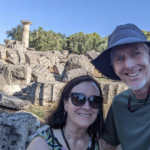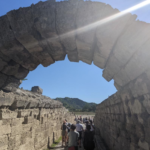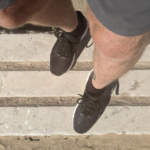 “We do not take a trip,” John Steinbeck wrote in his 1962 gem, Travels with Charley: In Search of America, “a trip take us.”
“We do not take a trip,” John Steinbeck wrote in his 1962 gem, Travels with Charley: In Search of America, “a trip take us.”
In 2022, in search of the Pompeii ruins in Italy during my Travels with Lisa, our 40th wedding anniversary trip took us to tears.
To learn that an estimated 2,000 inhabitants of this ancient city died in less than 15 minutes after Mount Vesuvius, less than 15 miles away, erupted two millennia ago is overwhelming. Indeed, imagining the horror of noon on August 11, 79 A.D. brings to mind the nightmare morning of September 11, 2001.
Strolling the cobblestone streets and alleyways, ducking into living quarters and brothels, seeing the basilica and amphitheatre and the massive main city square with a colossal statue of a centaur warrior, all brought on a sense of wonder.
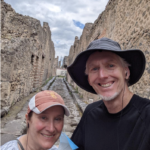
A narrow alleyway in the ancient ruins of Pompeii.
And yet it was a single room, small and simple, that brought on misty eyes. Here, one story represented every story on that calamitous day. Here, in a sarcophagus-like glass box, was a plaster casting of one of the exhumed victims. Here was a 14-year-old girl.
She died lying prone, forehead resting on her right forearm and left hand covering her nose and mouth, as though she were pleasantly sunbathing on a beach while shielding her eyes from the summer sun and face from wind-blown sand. In truth, she was trying to protect herself from the aerial tsunami of falling ash and swirling gasses that suffocated the residents of Pompeii – in the streets, in their homes, in their beds – long before the molten waves of lava arrived.
A steady line of tourists, hushed and solemn in expression, filed past the plaster girl with many snapping photographs as if this were merely an art sculpture imitating life – or, in this case, death.
The following day, 150 miles to the north in Rome, the Pompeiian girl seemed to reappear on the beautiful Ponte Vittorio Emanuele II pedestrian bridge spanning the Tibre River and connecting the historic city centre with the Vatican. Midway across, and also centered widthwise, was a life-sized sculpture. Instead of white plaster, it was cast iron and grey; instead of a girl in her home, it was a homeless man lying in a similar prone position with his forehead pillowed on a forearm. Again, tourists took pause to reflect in thought and take pictures.
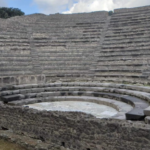
The amphitheatre with a stage of white marble.
Shortly past the end of the triple-arched stone bridge, less than a half-mile walk from St. Peter’s Basilica where the poor are daily blessed, was a third figure in a nearly identical pose as the ancient girl of plaster and the man of iron. But this was a real person, a man, in his fifties perhaps, lying on the sidewalk with his head turned to the side as if taking a swimmer’s breath, a raggedy blanket pulled up to his scraggy-bearded chin.
For all the attention given to the sculpture of a homeless man on the nearby landmark bridge; for all the reverence paid to the Pompeiian girl who died in a famous disaster long, long, long ago; the opposite was now the norm. The person still drawing breath seemed to draw only blind eyes, not empathy.
Homelessness is everydayness in most cities worldwide, yet the manner in which passerby’s collectively sidestepped and averted their eyes from a living person whereas they visually embraced a plaster girl and a cast-iron man, this juxtaposition was as silently heartbreaking as a thunderous Vesuvius eruption.
To be continued, more happily, in Rome in two weeks after the kickoff of Woody’s Holiday Ball Drive next week…
* * *
Essay copyrights Woody Woodburn
Woody writes a weekly column for The Ventura County Star and can be contacted at WoodyWriter@gmail.com. Follow him on Twitter and Instagram at @woodywoodburn. His SIGNED books are available at www.WoodyWoodburn.com.
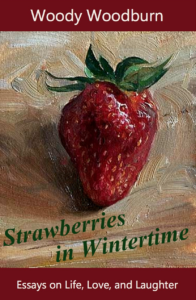
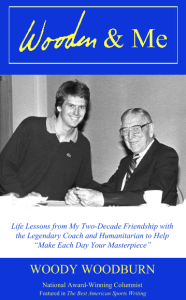 Personalized Signed copies of WOODEN & ME: Life Lessons from My Two-Decade Friendship with the Legendary Coach and Humanitarian to Help “Make Each Day Your Masterpiece” and “Strawberries in Wintertime: Essays on Life, Love, and Laughter” are available at WoodyWoodburn.com
Personalized Signed copies of WOODEN & ME: Life Lessons from My Two-Decade Friendship with the Legendary Coach and Humanitarian to Help “Make Each Day Your Masterpiece” and “Strawberries in Wintertime: Essays on Life, Love, and Laughter” are available at WoodyWoodburn.com

